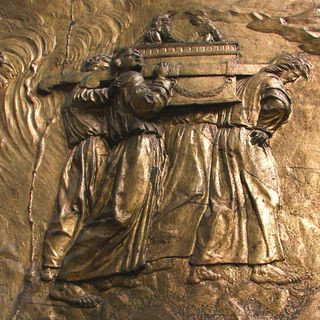The Ark of the Covenant, a sacred chest believed to have housed the tablets of the Ten Commandments given to Moses, stands as one of the most enigmatic and sought-after artifacts in biblical history. Described in the Hebrew Bible and Christian Old Testament, this golden vessel is not just a container; it’s a symbol of God’s presence and power, shrouded in mystery and tales of miraculous abilities. But where is the Ark of the Covenant today? Its disappearance centuries ago has fueled countless expeditions, scholarly debates, and captivating legends, making its current location one of the greatest unsolved mysteries in religious archaeology.
According to biblical narrative, the Ark was meticulously crafted by the Israelites during their wanderings in the Sinai Desert after their exodus from ancient Egypt. While the precise timing of this exodus remains a subject of scholarly discussion, the Ark’s significance is undeniable. The Hebrew Bible recounts extraordinary powers attributed to the Ark. One famous account details how the Ark miraculously halted the flow of the Jordan River, allowing priests carrying it to cross on dry ground. Furthermore, stories abound of the Israelites carrying the Ark into battle, believing its divine presence would secure victory against their adversaries.
 Building of the Ark of the Covenant
Building of the Ark of the Covenant
The Israelites are supposed to have built the ark to very particular specifications, laid out by God after he gave Moses the Ten Commandments. (Image credit: BibleArtLibrary via Getty Images)
However, the Ark’s seemingly invincible power was challenged when, as recorded, the Philistines captured it. As Susan Ackerman notes in the “Eerdmans Dictionary of the Bible,” this capture initially cast doubt on its military effectiveness. The Philistines’ triumph was short-lived, though. The Bible recounts that outbreaks of tumors and disease plagued them while they held the Ark, compelling them to return it to the Israelites. Adding to the mystique, tales circulated about the deadly consequences for anyone who dared to touch or gaze inside the Ark, further solidifying its status as a sacred object to be revered and feared.
The Vanishing Act: Jerusalem and Beyond
The Hebrew Bible details the Ark’s movements throughout early Israelite history. Eventually, it found a permanent home in Jerusalem, within the innermost sanctum of the Temple. As Ackerman points out, the story of its arrival in Jerusalem is recounted in 2 Samuel 6 and Psalm 132. Later, it was enshrined in the Holy of Holies within Solomon’s Temple, constructed around 957 B.C. Yet, the Ark’s narrative takes an abrupt turn after Solomon’s reign. While Jewish tradition and most scholars believe it remained in the Temple for nearly four centuries, until Jerusalem’s fall to the Babylonians in 586 B.C., a crucial detail is missing: the Ark is absent from the list of spoils taken by the Babylonians. This absence has led some to speculate that the Ark might have already been removed from Jerusalem, perhaps as early as the late 10th century B.C., during Pharaoh Shishak’s military campaign during the reign of Rehoboam, Solomon’s son.
 Engraving depicting the Ark of the Covenant. Image shot 1885. Exact date unknown.
Engraving depicting the Ark of the Covenant. Image shot 1885. Exact date unknown.
Engraving depicting the Ark of the Covenant. Image shot 1885. Exact date unknown. (Image credit: Alamy)
The question then becomes: what happened to the Ark of the Covenant after the First Temple’s destruction? The Book of Maccabees offers one compelling theory, suggesting that the prophet Jeremiah concealed the Ark in a cave on Mount Nebo. Jeremiah declared, according to 2 Maccabees 2:7, that this location would remain unknown until God reunited his people and showed his mercy.
Legends and Locations: From Ethiopia to Jordan
Another prominent legend proposes that the Ark was transported to Ethiopia and is currently housed in the Church of Our Lady Mary of Zion in Axum. Tradition dictates that only the Guardian of the Ark is permitted to view it. Interestingly, scholar Edward Ullendorff claimed to have seen the Axum Ark during World War II, concluding it was not the original. Despite this, the Ethiopian Orthodox Church maintains its claim of possessing the true Ark, adding another layer to the mystery.
The Quran presents yet another narrative, placing the Ark’s concealment in Jordan. This account, as explained by Tudor Parfitt, a religion professor at Florida International University, in his book “The Lost Ark of the Covenant,” draws loosely from the Apocryphal second book of Maccabees. It recounts Jeremiah carrying the Ark across the Jordan River before the Babylonian conquest, hiding it in a cave on Mount Nebo – the same mountain from which Moses viewed the Promised Land – and sealing the cave’s entrance. Parfitt notes that some followers attempted to retrace Jeremiah’s steps, but the prophet rebuked them, stating the Ark would remain hidden until the end times.
 This bas-relief image showing the Ark of the Covenant being carried is from the Auch Cathedral in France. A newly translated Hebrew text claims to reveal the locations of treasures from King Solomon
This bas-relief image showing the Ark of the Covenant being carried is from the Auch Cathedral in France. A newly translated Hebrew text claims to reveal the locations of treasures from King Solomon
This bas-relief image showing the Ark of the Covenant being carried is from the Auch Cathedral in France. A newly translated Hebrew text claims to reveal the locations of treasures from King Solomon’s Temple and discusses the fate of the Ark itself. (Image credit: Photo by I. Vassil, released into public domain through Wikimedia)
Beyond these prominent theories, numerous other stories exist regarding the Ark’s survival, as Parfitt details in his research. These tales place the Ark in locations ranging from the vicinity of Jerusalem to Mecca and even as far afield as New Guinea, highlighting the widespread fascination and enduring mystery surrounding its fate.
Adding a theological dimension to the enigma, the “Treatise of the Vessels” asserts the Ark “shall not be revealed until the day of the coming of the Messiah son of David.” Similarly, the Book of Revelation in the Christian Bible suggests the Ark will reappear only in the end times: “Then God’s temple in heaven was opened, and within his temple was seen the Ark of his Covenant” (Revelation 11:19), linking its rediscovery to apocalyptic events.
Construction Conundrums: Gold and Wood
Adding to the complexity of the Ark’s story are differing biblical accounts of its construction. The Book of Exodus provides the most elaborate description, detailing God’s instructions to Moses for a gold-covered ark. Exodus 25:10-11 specifies acacia wood construction, overlaid inside and out with pure gold, and adorned with a gold molding. It also describes acacia wood and gold poles for carrying, and two golden cherubim placed atop the lid, their wings spread to overshadow it and faces directed towards each other. This Ark was intended to house the tablets of the Ten Commandments.
In contrast, the Book of Deuteronomy presents a different, more modest account. It recounts Moses’s anger at the Israelites’ worship of the golden calf, leading him to break the original stone tablets. God then instructed Moses to create new tablets and a simple wooden ark to contain them (Deuteronomy 10:1-2). Moses subsequently constructed an acacia wood ark for the replacement tablets (Deuteronomy 10:3-4).
Multiple Arks? A Plausible Explanation
The discrepancies in construction accounts and the Ark’s varied history have led some scholars to propose the existence of multiple arks. Parfitt suggests that before worship centralized in Jerusalem, various arks, possibly of differing designs and materials, may have existed in different locations where God was worshipped. These earlier arks were likely simpler wooden containers. As Israelite worship became centralized in Jerusalem, the narrative may have evolved to focus on a single, magnificent Ark of the Covenant, embellished with gold, becoming the iconic image we know today.
The Enduring Mystery
The question “where is the Ark of the Covenant?” remains unanswered. Despite numerous theories, legends, and searches, the Ark’s current location is unknown. Whether it rests hidden on Mount Nebo, resides in an Ethiopian church, or vanished entirely, the mystery of the Ark of the Covenant continues to captivate and intrigue. Its disappearance has transformed it into more than just a religious artifact; it has become a symbol of faith, mystery, and the enduring quest for the sacred.
Bibliography
- Ackerman, Susan. “Ark of the Covenant.” Eerdmans Dictionary of the Bible. Edited by David Noel Freedman, Eerdmans, 2000.
- Parfitt, Tudor. The Lost Ark of the Covenant: Solving the 2,500 year-old Mystery of the Fabled Biblical Ark. Harper Collins, 2008.
- The Book of Exodus
- The Book of Deuteronomy
- The Book of Maccabees
- The Book of Revelation
- Treatise of the Vessels
